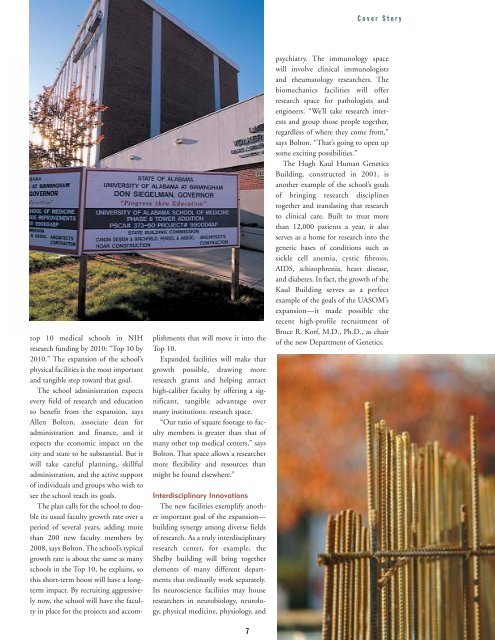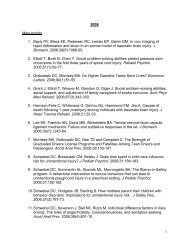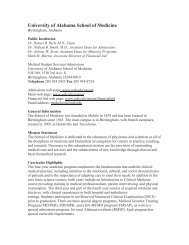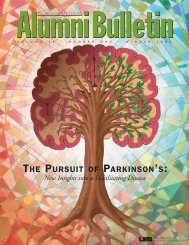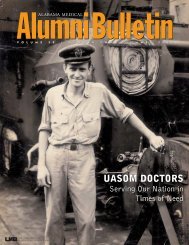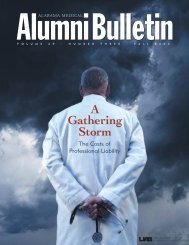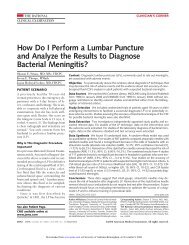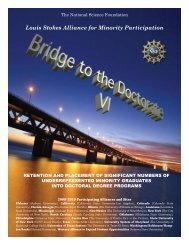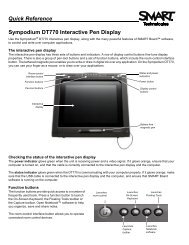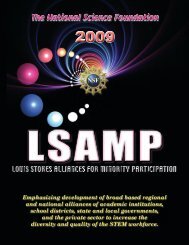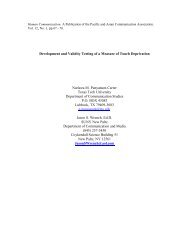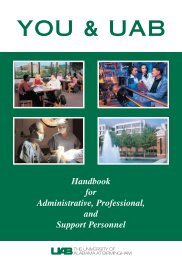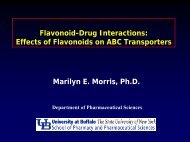AlumniBulletin - University of Alabama at Birmingham
AlumniBulletin - University of Alabama at Birmingham
AlumniBulletin - University of Alabama at Birmingham
Create successful ePaper yourself
Turn your PDF publications into a flip-book with our unique Google optimized e-Paper software.
Cover Story<br />
top 10 medical schools in NIH<br />
research funding by 2010: “Top 10 by<br />
2010.” The expansion <strong>of</strong> the school’s<br />
physical facilities is the most important<br />
and tangible step toward th<strong>at</strong> goal.<br />
The school administr<strong>at</strong>ion expects<br />
every field <strong>of</strong> research and educ<strong>at</strong>ion<br />
to benefit from the expansion, says<br />
Allen Bolton, associ<strong>at</strong>e dean for<br />
administr<strong>at</strong>ion and finance, and it<br />
expects the economic impact on the<br />
city and st<strong>at</strong>e to be substantial. But it<br />
will take careful planning, skillful<br />
administr<strong>at</strong>ion, and the active support<br />
<strong>of</strong> individuals and groups who wish to<br />
see the school reach its goals.<br />
The plan calls for the school to double<br />
its usual faculty growth r<strong>at</strong>e over a<br />
period <strong>of</strong> several years, adding more<br />
than 200 new faculty members by<br />
2008, says Bolton. The school’s typical<br />
growth r<strong>at</strong>e is about the same as many<br />
schools in the Top 10, he explains, so<br />
this short-term boost will have a longterm<br />
impact. By recruiting aggressively<br />
now, the school will have the faculty<br />
in place for the projects and accomplishments<br />
th<strong>at</strong> will move it into the<br />
Top 10.<br />
Expanded facilities will make th<strong>at</strong><br />
growth possible, drawing more<br />
research grants and helping <strong>at</strong>tract<br />
high-caliber faculty by <strong>of</strong>fering a significant,<br />
tangible advantage over<br />
many institutions: research space.<br />
“Our r<strong>at</strong>io <strong>of</strong> square footage to faculty<br />
members is gre<strong>at</strong>er than th<strong>at</strong> <strong>of</strong><br />
many other top medical centers,” says<br />
Bolton. Th<strong>at</strong> space allows a researcher<br />
more flexibility and resources than<br />
might be found elsewhere.”<br />
Interdisciplinary Innov<strong>at</strong>ions<br />
The new facilities exemplify another<br />
important goal <strong>of</strong> the expansion—<br />
building synergy among diverse fields<br />
<strong>of</strong> research. As a truly interdisciplinary<br />
research center, for example, the<br />
Shelby building will bring together<br />
elements <strong>of</strong> many different departments<br />
th<strong>at</strong> ordinarily work separ<strong>at</strong>ely.<br />
Its neuroscience facilities may house<br />
researchers in neurobiology, neurology,<br />
physical medicine, physiology, and<br />
7<br />
psychi<strong>at</strong>ry. The immunology space<br />
will involve clinical immunologists<br />
and rheum<strong>at</strong>ology researchers. The<br />
biomechanics facilities will <strong>of</strong>fer<br />
research space for p<strong>at</strong>hologists and<br />
engineers. “We’ll take research interests<br />
and group those people together,<br />
regardless <strong>of</strong> where they come from,”<br />
says Bolton. “Th<strong>at</strong>’s going to open up<br />
some exciting possibilities.”<br />
The Hugh Kaul Human Genetics<br />
Building, constructed in 2001, is<br />
another example <strong>of</strong> the school’s goals<br />
<strong>of</strong> bringing research disciplines<br />
together and transl<strong>at</strong>ing th<strong>at</strong> research<br />
to clinical care. Built to tre<strong>at</strong> more<br />
than 12,000 p<strong>at</strong>ients a year, it also<br />
serves as a home for research into the<br />
genetic bases <strong>of</strong> conditions such as<br />
sickle cell anemia, cystic fibrosis,<br />
AIDS, schizophrenia, heart disease,<br />
and diabetes. In fact, the growth <strong>of</strong> the<br />
Kaul Building serves as a perfect<br />
example <strong>of</strong> the goals <strong>of</strong> the UASOM’s<br />
expansion—it made possible the<br />
recent high-pr<strong>of</strong>ile recruitment <strong>of</strong><br />
Bruce R. Korf, M.D., Ph.D., as chair<br />
<strong>of</strong> the new Department <strong>of</strong> Genetics.


